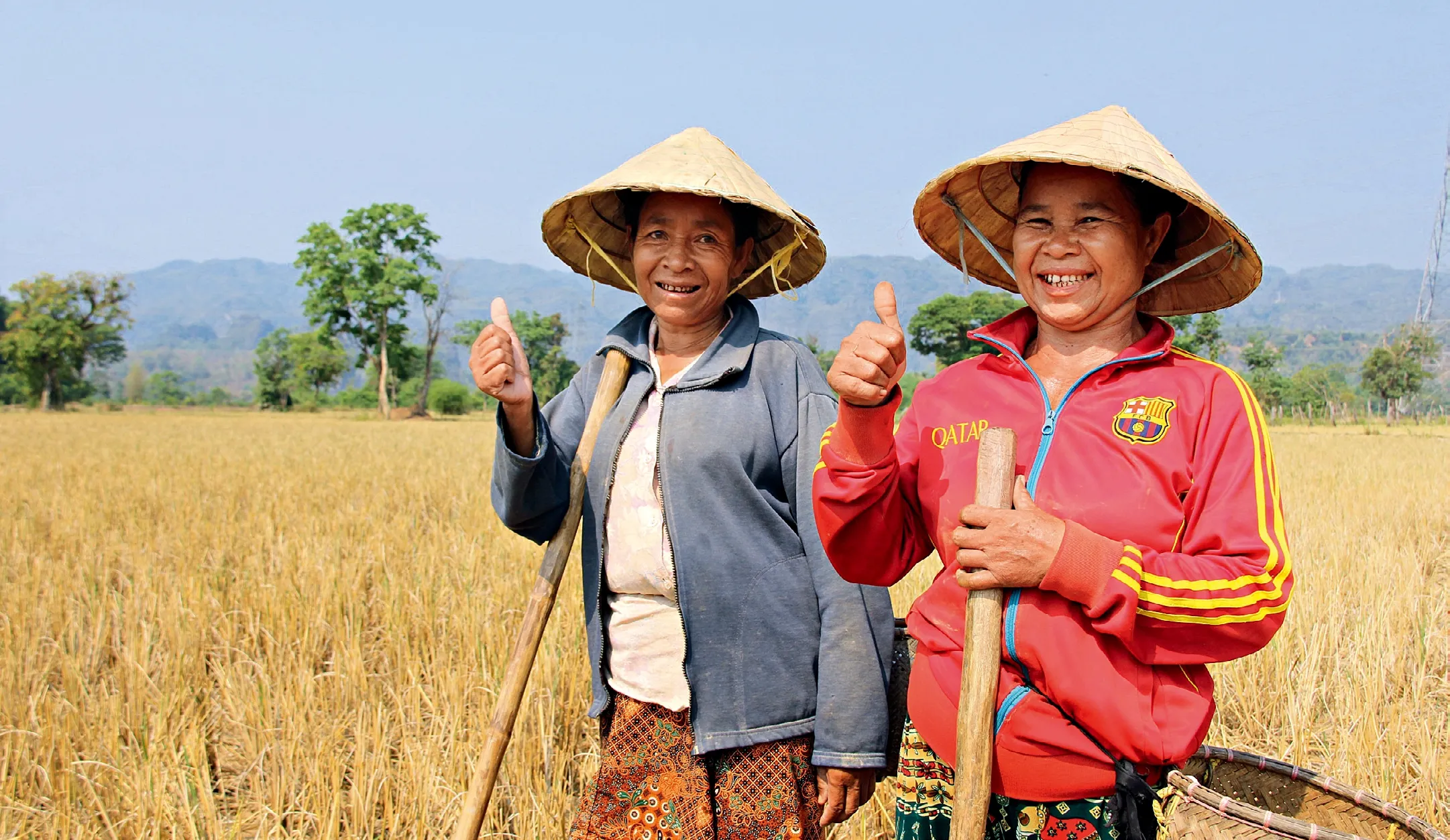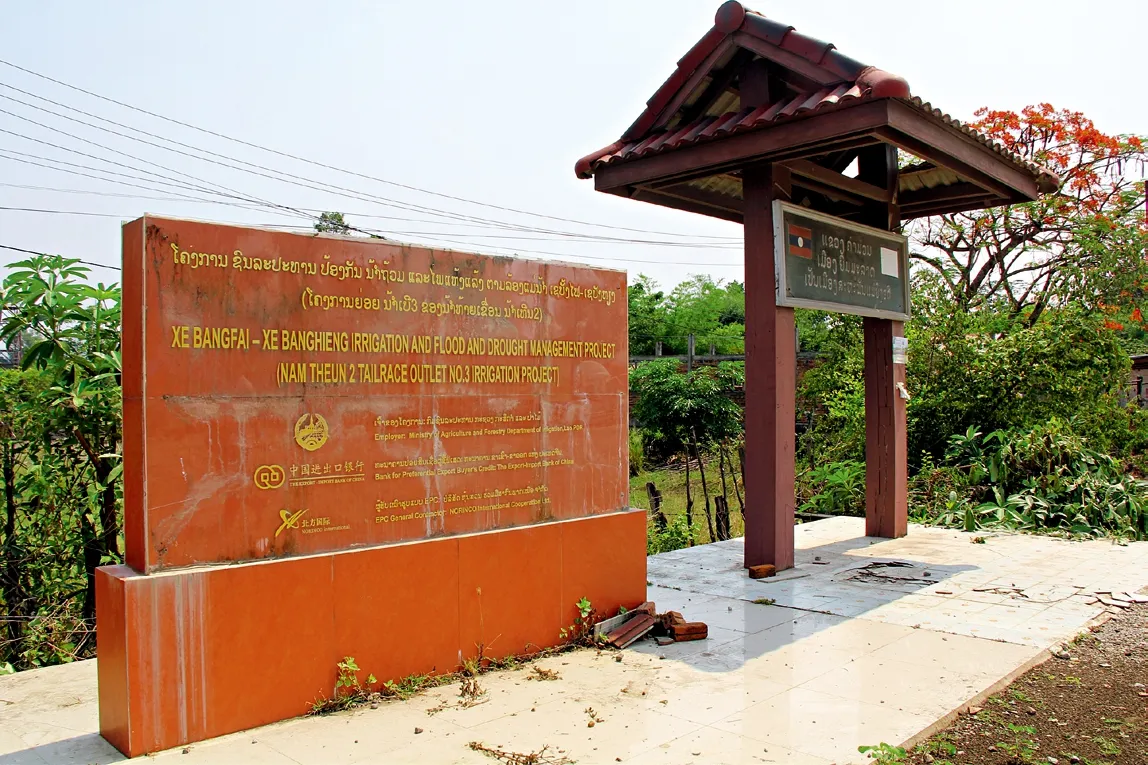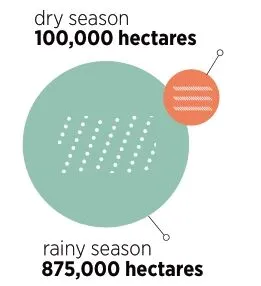COOPERATIVE BOUNTY
By Sun Guangyong
Irrigation project built by China is helping increase rice yields in Laos

Farmers give the thumbs-up to the Nam Theun 2 tailrace outlet No. 3 irrigation project built by Chinese enterprises in Laos.
M ore than 400 kilometers southeast from Vientiane,the capital of Laos,Nongping Village is in Laos’central Khammouane Province.Hundreds of stilt houses are scattered on both sides of its roads, and under many of them are piles of rice drying in the sun.
May is the dry season in Laos. The rice fields in the village have been reaped,and several cattle continue to brave the scorching sun.Senior villager Drokhan drives a tractor to plow a recently harvested field, leaving a trail of turned soil in rows like rolling waves. “Rainy season is coming soon,” he notes. “I need to get the field ready so I can plant rice seedlings before it rains. If it doesn’t rain, I will get water from the irrigation canal just next to the paddy field.”
Hard-won Harvests
“We can harvest four tons of rice per hectare during rainy season, but the yield increases to five tons during dry season because of stable irrigation,” exclaims a villager.“The rainfall comes and goes during the wet season, which is not optimal for rice to grow.The better yields should indeed be attributed to the irrigation project China has helped build.”

The Nam Theun 2 tailrace outlet No. 3 irrigation project built by Chinese enterprises in Nhommalath District, Khammouane Province of Laos.

A roadside signboard of the Nam Theun 2 tailrace outlet No. 3 irrigation project.
The project is an irrigation scheme utilizing water discharged from outlet No. 3 of the Nam Theun 2 Hydroelectric Project, located in Nhommalath District,Khammouane Province. A key infrastructure project included in the Laos national socio-economic development plan, it is also part of the first phase of the country’s Xe Bangfai-Xe Banghieng Irrigation and Flood and Drought Management Project.Funded by China’s preferential buyer’s credit and constructed by China-based NORINCO International Cooperation Ltd., the 101-kilometer-long irrigation system is composed of a three-level canal network and drainage channels and has the capacity to water over 2,800 hectares of farmland.Since it was completed in 2015, the project has greatly improved the living conditions of the people inhabiting the irrigated areas, increased food production and reduced flood damage.
The Xe Bangfai River is an important tributary of the Mekong River. With more than 100,000 hectares of land suitable for agricultural activities, the Xe Bangfai River basin has been a key region of central Laos for producing cereal crops. In the past,several small-scale irrigation and flood control projects were built along the river but only with limited capacity,leaving villages and farmland downstream under constant threat of droughts and floods.
The fertile soil in the densely populated Xe Bangfai River basin is ideal for rice and tropical crops, and it can produce two or three crops in a single year. However, rainfall in the dry season is enough for only 8 percent of the farmland along the river. According to Mr. Phetsakhone, a Lao official from the Department of Irrigation, Ministry of Agriculture and Forestry, who is in charge of the irrigation project, after the tail water of Nam Theun 2 was channeled to the Xe Bangfai River, the river flow in the dry season increased, providing sufficient irrigation water for about 100,000 hectares of farmland along both banks. The irrigation facility has played an important role in improving food production and helping boost local incomes and reduce poverty.
With the irrigation system in operation, the lives of farmers in Nongping Village have been greatly improved. “Thanks to the irrigation project, not only have we expanded our rice field, but we also plant other cash crops,” reveals a villager named Banong. “Our income has increased because now we grow rice, vegetables and fruit and breed fish. We no longer worry about our children’s tuition or consider going abroad to work. Our family is very happy together.”
“A total of 1,300 farming households in nine villages have benefited from the Nam Theun 2 tailrace outlet No. 3 irrigation project,” estimates Mr. Phetsakhone. “The facility provides a stable source of irrigation water for 2,800 hectares of paddies and other cash crops. At the project completion ceremony, then-Deputy Prime Minister of Laos Somsavat Lengsavad struck a gong 12 times to ask for a constant flow of water 12 months a year and a good harvest every year.”
Covering an area of nearly 120,000 hectares, Nhommalath District is home to more than 35,000 residents in 46 villages. “Now seven irrigation systems water a combined 7,000 hectares of rice and other crops in the entire district,and the longest one was built by China,” notes the district’s agriculture and forestry bureau chief. “These facilities have helped expand arable land,reduce the damage of floods and boost crop yield. The rice produced in the wet season is basically consumed by the local households while the yield in the dry season is purchased by cooperatives in the villages for export to countries like Thailand and Vietnam. We hope to sell our rice to China in the future.”

90% Laos remains an agrarian society,and about 90 percent of its population is engaged in agriculture.

The country’s rice paddies in rainy season amount to 875,000 hectares,while in the dry season a mere 100,000 hectares of land in irrigated area are suitable for rice cultivation.
The Nam Theun 2 tailrace outlet No. 3 irrigation project is a typical example of how China-Laos water resource cooperation has transformed from vision to reality.
China’s Experience
Laos remains an agrarian society, and about 90 percent of its population is engaged in agriculture. High-quality organic rice produced in the country is available for export after meeting domestic demand. However, the yield of rice per unit area in Laos remains relatively low due to dated farming techniques and equipment. Without complete irrigation systems, the rice paddy area becomes much smaller in the dry season. Some parts of the nation can only grow one crop a year, which is highly inefficient utilization of farmland.
Over the years, the Lao government has been committed to the development of irrigation facilities to secure water supply and improve agricultural production. Listed as a government priority,rice farming has received strong policy and financial support. “Agriculture is an important pillar of Laos’economy,” stresses Maykong Phonephommavong, general director of the Department of Irrigation, Ministry of Agriculture and Forestry.“The government has made steady progress in improving agricultural infrastructure such as irrigation systems and power supply in rural areas.Farmers are encouraged to use quality seeds and modern techniques. We have also increased government support for rice cultivation, processing and exporting.”
According to Maykong, the country’s rice paddies in rainy season amount to 875,000 hectares, while in the dry season a mere 100,000 hectares of land in irrigated area are suitable for rice cultivation.“The Nam Theun 2 tailrace outlet No. 3 irrigation facility is a major project sponsored by Lao Ministry of Agriculture and Forestry,” he adds. “By building a new canal network and upgrading smaller farmland water conservation facilities,more farmland is getting watered, and more crops are being harvested.”
“With the help of the irrigation project, the rice yield in the region has doubled to four to five tons of rice per hectare,” reveals Maykong.“Our Chinese friends have helped us develop agricultural facilities and lift local people out of poverty not only in Khammouane Province but also in other parts of the country. Lao technicians from the Ministry of Agriculture and Forestry often visit China to attend training programs on irrigation, cultivation, forestry and aquaculture. For example,I have made many visits to Yunnan Province, where the geographical environment and structure of cultivated plants are similar to Laos. We have learned a lot from China’s practices in agricultural production and acquired new farming skills.”
On April 30, 2019, China and Laos signed an action plan to build a China-Laos community with a shared future. To increase Laos’ agricultural output and added value of its agricultural products and promote the development of sustainable and exportoriented agriculture, according to the document, China will send experts to Laos to train local farmers and help raise their incomes, and the two countries will work together to build a demonstration park for modern agriculture.“This agreement presents unprecedented opportunity for Laos,” opines Lao National Assembly member Khampheuy Vongsakhamphoui.
The Nam Theun 2 tailrace outlet No. 3 irrigation project is a typical example of how China-Laos water resource cooperation has transformed from vision to reality. Based on close communication within the Lancang-Mekong Cooperation (LMC)mechanism, the two countries have carried out fruitful water resource cooperation in information sharing, personnel training, joint research and projects supported by the LMC fund. China is currently Laos’largest investor and second largest trading partner. It has made continuous efforts to launch cooperation projects in poverty-stricken areas of Laos in various fields including infrastructure, public services,farmers’ livelihoods and poverty reduction.
Vice Foreign Minister of Laos Thongphan Savanphet noted that since its inception,the LMC has made rapid progress and delivered tangible benefits to people across the sub-region. He stressed that Laos will continue its active participation in the mechanism to promote sub-regional development and prosperity.
12O,OOO hectares
35,OOO residents
46 villages
7 irrigation systems
7,OOO hectares
Covering an area of nearly 120,000 hectares,Nhommalath District is home to more than 35,000 residents in 46 villages. Seven irrigation systems water a combined 7,000 hectares of rice and other crops in the entire district, and the longest one was built by China.

